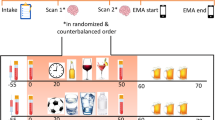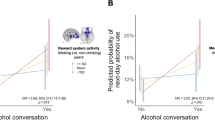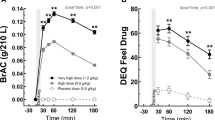Abstract
Using fMRI, our group previously found that after a sip of alcohol and exposure to alcohol beverage pictures, alcoholics compared to social drinkers had increased differential brain activity in the prefrontal cortex and anterior thalamus. This study extends this earlier work with several improvements including imaging the entire brain (rather than the anterior half previously) and recording craving, while the subjects viewed images within the scanner. In a Philips 1.5 T MRI scanner, 10 nontreatment-seeking alcoholics and 10 age-matched healthy social drinkers were given a sip of alcohol before viewing a 12 min randomized presentation of pictures of alcoholic beverages, nonalcoholic beverages, and two different visual control tasks. During picture presentation, changes in regional brain activity were measured in 15 transverse T2*-weighted blood oxygen level dependent slices. Subjects rated their urge to drink after each picture sequence. After a sip of alcohol, while viewing alcohol cues compared to viewing other beverage cues, the alcoholics, but not social drinkers, reported higher craving ratings and had increased activity in the prefrontal cortex and anterior limbic regions. Brain activity in the left nucleus accumbens, anterior cingulate, and left orbitofrontal cortex significantly correlated with subjective craving ratings in alcohol subjects but not in control subjects. This study suggests, as did our earlier study, that alcoholics and not social drinkers, when exposed to alcohol cues, have increased brain activity in areas that reportedly subserve craving for other addictive substances.
Similar content being viewed by others
Log in or create a free account to read this content
Gain free access to this article, as well as selected content from this journal and more on nature.com
or
References
Anderson SW, Bechara A, Damasio H, Tranel D, Damasio AR (1999). Impairment of social and moral behavior related to early damage in human prefrontal cortex. Nat Neurosci 11: 1032–1037.
Anton RF (1999). What is craving? Models and implications for treatment. Alcohol Res Health 23: 165–173.
Anton RF, Drobes DJ (1998). Clinical measurement of craving in addiction. Psych Annals 28: 553–560.
Anton RF, Moak DH, Latham P. (1995). The obsessive compulsive drinking scale: a self-rated instrument for the quantification of thoughts about alcohol and drinking behavior. Alcoholism: Clin Exp Res 19: 92–99.
Anton RF, Moak DH, Latham PK (1996). The obsessive compulsive drinking scale. A new method of assessing outcome in alcoholism treatment studies. Arch Gen Psychiatry 53: 225–231.
Balleine BW, Dickinson A (2000). The effect of lesions of the insular cortex on instrumental conditioning: evidence for a role in incentive memory. J Neurosci 20: 8954–8964.
Bechara A, Damasio AR, Damasio H, Anderson SW (1994). Insensitivity to future consequences following damage to human prefrontal cortex. Cognition 50: 7–12.
Berridge KC, Robinson TE (1998). What is the role of dopamine in reward: hedonic impact, reward learning, or incentive salience? Brain Res Brain Res Rev 28: 309–369.
Bonson KR, Grant SJ, Contoreggi CS, Links JM, Metcalfe J, Weyl HL et al (2002). Neural systems and cue-induced cocaine craving. Neuropsychopharmacology 26: 376–386.
Braun JJ, Slick TB, Lorden JF (1972). Involvement of gustatory neocortex in the learning of taste aversions. Physiol Behav 9: 637–641.
Braus DF, Wrase J, Grusser S, Hermann D, Ruf M, Flor H et al (2001). Alcohol-associated stimuli activate the ventral striatum in abstinent alcoholics. J Neural Transmission 108: 887–894.
Breiner MJ, Stritzke WGK, Lang AR, Patrick CJ (1995). The Normative Appetitive Picture System [Photographic Slides]. Florida State University: Tallahassee.
Breiter HC, Gollub RL, Weisskoff RM, Kennedy DN, Makris N, Berke JD, Goodman JM et al (1997). Acute effects of cocaine on human brain activity and emotion. Neuron 19: 591–611.
Brody AL, Mandelkern MA, London ED, Childress AR, Lee GS, Bota RG et al (2002). Brain metabolic changes during cigarette craving. Arch Gen Psych 59: 1162–1172.
Bush G, Luu P, Posner MI (2000). Cognitive and emotional influences in anterior cingulate cortex. Trends Cognitive Sci 4: 215–222.
Childress AR, Mozley PD, McElgin W, Fitzgerald J (1999). Limbic activation during cue-induced cocaine craving. Am J Psychiatry 156: 11–18.
CSEA-NIMH (1995). The International Affective Picture System [Photographic Slides]. University of Florida: Gainesville.
De Wit H (2000). Laboratory-based assessment of alcohol craving in social drinkers. Addiction 95: S165–S169.
Flannery BA, Roberts AJ, Cooney N, Swift RM, Anton RF, Rohsenow DJ (2001). The role of craving in alcohol use, dependence, and treatment. Alcohol Clin Exp Res 25: 299–308.
Garavan H, Pankiewicz J, Bloom A, Cho JK, Sperry L, Ross TJ et al (2000). Cue-induced cocaine craving: neuroanatomical specificity for drug users and drug stimuli. Am J Psychiatry 157: 1789–1798.
George MS, Anton RF, Bloomer C, Teneback C, Drobes DJ, Lorberbaum JP et al (2001). Activation of prefrontal cortex and anterior thalamus in alcoholic subjects on exposure to alcohol-specific cues. Arch Gen Psychiatry 58: 345–352.
Grant S, London ED, Newlin DB, Villemagne VL, Liu X, Contoreggi C et al (1996). Activation of memory circuits during cue-elicited cocaine craving. Proc Natl Acad Sci USA 93: 12040–12045.
Haber SN, Kunishio K, Mizobuchi M, Lynd-Balta E (1995). The orbital and medical prefrontal circuit through the primate basal ganglia. J Neurosci 15: 4851–4867.
Heinz A (1999). Neurobiological and anthropological aspects of compulsions and rituals. Pharmacopsychiatry 32: 223–229.
Hommer D, Andreasen P, Rio D, Williams W, Ruttimann U, Momenan R et al (1997). Effects of m-chlorophenylpiperazine on regional brain glucose utilization: a positron emission tomographic comparison of alcoholic and control subjects. J Neurosci 17: 2796–2806.
Ikemoto S, Panksepp J (1999). The role of nucleus accumbens dopamine in motivated behavior: a unifying interpretation with special reference to reward-seeking. Brain Res Brain Res Rev 31: 6–41.
Jaffe AJ, Rounsaville B, Chang G, Schottenfield RS, Meyer RE, O'Malley SS (1996). Naltrexone, relapse prevention, and supportive therapy with alcoholics: an analysis of patient treatment matching. J Consult Clin Psychol 64: 1044–1053.
Kiefer SW, Braun JJ (1977). Absence of differential associative responses to novel and familiar taste stimuli in rats lacking gustatory neocortex. J Comp Physiol Psychol 91: 498–507.
Kilts CD, Schweitzer JB, Quinn CK, Gross RE, Faber TL, Muhammad F et al (2001). Neural activity related to drug craving in cocaine addiction. Arch Gen Psychiatry 58: 334–341.
Knutson B, Adams CM, Fong GW, Hommer D (2001). Anticipation of increasing monetary reward selectively recruits nucleus accumbens. J Neurosci 21: RC159.
Koob GF, Le Moal M (1997). Drug abuse: hedonic hemostatic dysregulation. Science 278: 52–58.
Krettek JE, Price JL (1977). Projections from the amygdaloid complex and adjacent olfactory structures to the entorhinal cortex and to the subiculum in the rat and cat. J Comp Neurol 172: 723–752.
London ED, Ernst M, Grant S, Bonson K, Weinstein A (2000). Orbitofrontal cortex and human drug abuse: functional imaging. Cerebral Cortex 10: 334–342.
Mass LC, Lukas SE, Kaufman MJ, Weiss RD, Daniels SL, Rodgers VW et al (1998). Functional magnetic resonance imaging of human brain activation during cue-induced cocaine craving. Am J Psychiatry 155: 124–126.
Modell JG, Mountz JM (1995). Focal cerebral blood flow change during craving for alcohol measured by SPECT. J Neuropsychol 7: 15–22.
Modell JG, Mountz JM, Beresford TP (1990). Basal ganglia/limbic striatal and thalamocortical involvement in craving and loss of control in alcoholism. J Neuropsychiatry Clin Neurosci 2: 123–144.
O'Malley SS, Krishnan-Sarin S, Farren C, Sinha R, Kreek J (2002). Naltrexone decreases craving and alcohol self-administration in alcohol-dependent subjects and activates the hypothalamo-pituitary-adrenocortical axis. Psychopharmacology (Berlin) 160: 19–29.
Pointieri F, Tanda G, Di Chiara G (1995). Intravenous cocaine, morphine, and amphetamine preferentially increased extracellular dopamine in the ‘shell’ as compared with the ‘core’ of the rat nucleus accumbens. Proc Natl Acad Sci USA 92: 12304–12308.
Schneider F, Habel U, Wagner M, Franke P, Salloum JB, Shah NJ et al (2001). Subcortical correlates of craving in recently abstinent alcoholic patients. Am J Psychiatry 158: 1075–1083.
Schultz W, Appicella P, Scarnati E, Ljungber T (1992). Neuronal activity in monkey ventral striatum related to the expectation of reward. J Neurosci 12: 4595–4610.
Sell LA, Morris JS, Bearn J, Frackowiak RS, Friston KJ, Dolan RJ (2000). Neural response associated with cue evoked emotional states and heroin in opiate addicts. Drug Alcohol Dependence 60: 207–216.
Shidara M, Richmond BJ (2002). Anterior cingulate: single neuronal signals related to degree of reward expectany. Science 296: 1709–1711.
Shinonaga Y, Takada M, Mizuno N (1994). Topographic organization of collateral projections from the baso-lateral amygdaloid nucleus to both the prefrontal cortex and nucleus accumbens in the rat. Neuroscience 58: 389–397.
Sobell LC, Sobell MB, Leo GI, Cancilla A (1988). Reliability of a timeline method: assessing normal drinkers' reports of recent drinking and a comparative evaluative across several populations. Br J Addict 83: 393–402.
Sullivan JT, Sykora K, Schneiderman J, Naranjo CA, Sellers EM (1989). Assessment of alcohol withdrawal: the revised Clinical Institute Withdrawal Assessment for Alcohol Scale (CIWA-Ar). Br J Addict 84: 1353–1357.
Talairach J, Tournoux P (1988). Co-planar Stereotaxic Atlas of the Human Brain: 3-Dimensional Proportional System: An Approach to Cerebral Imaging. Thieme-Stratton, Inc.: New York.
Volkow N, Fowler J (2000). Addiction, a disease of compulsion and drive: involvement of the orbitofrontal cortex. Cereb Cortex 10: 318–325.
Wang GJ, Volkow ND, Fowler JS, Cervany P, Hitzemann RJ, Pappas NR et al (1999). Regional brain metabolic activation during craving elicited by recall of previous drug experiences. Life Sci 64: 775–784.
Wexler BE, Gottschalk CH, Fulbright RK, Prohovnik I, Lacadie CM, Rounsaville BJ et al (2001). Functional magnetic resonance imaging of cocaine craving. Am J Psychiatry 158: 86–95.
Woods RP, Cherry SR, Mazziotta JC (1992). Rapid automated algorithm for aligning and reslicing PET images. J Comput Assist Tomogr 16: 620–633.
Wright CI, Groenewegan HJ (1996). Patterns of overlap and segregation between insular cortical, intermediodorsal thalamic and basal amygdaloid afferents in the nucleus accumbens of the rat. Neuroscience 73: 359–373.
Zald DH, Kim SW (1996). The anatomy and function of the orbitofrontal cortex. I: Anatomy, neurocircuitry, and obsessive-compulsive disorder. J Neuropsychiatry Clin Neurosci 8: 125–138.
Acknowledgements
This work was funded by the Charleston Alcohol Research Center (ARC) (NIAAA 2 P50 AA10761-03). Dr Myrick is also funded through NIAAA K23 AA00314 and the VA Research and Development Service, Ralph H Johnson Department of Veterans Affairs Medical Center. There are no conflicts of interest, financial or otherwise, between any of the authors and any other person or entity that might bias the results of this study.
Author information
Authors and Affiliations
Corresponding author
Rights and permissions
About this article
Cite this article
Myrick, H., Anton, R., Li, X. et al. Differential Brain Activity in Alcoholics and Social Drinkers to Alcohol Cues: Relationship to Craving. Neuropsychopharmacol 29, 393–402 (2004). https://doi.org/10.1038/sj.npp.1300295
Received:
Revised:
Accepted:
Published:
Issue date:
DOI: https://doi.org/10.1038/sj.npp.1300295
Keywords
This article is cited by
-
Adaptor protein complex 2 in the orbitofrontal cortex predicts alcohol use disorder
Molecular Psychiatry (2023)
-
The effects of nalmefene on the impulsive and reflective system in alcohol use disorder: A resting-state fMRI study
Psychopharmacology (2022)
-
Functional and clinical outcomes of FMRI-based neurofeedback training in patients with alcohol dependence: a pilot study
European Archives of Psychiatry and Clinical Neuroscience (2022)
-
Translational opportunities in animal and human models to study alcohol use disorder
Translational Psychiatry (2021)
-
The role of the orbitofrontal cortex and the nucleus accumbens for craving in alcohol use disorder
Translational Psychiatry (2021)



